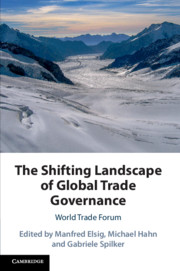Book contents
- The Shifting Landscape of Global Trade Governance
- The Shifting Landscape of Global Trade Governance
- Copyright page
- Contents
- Figures
- Tables
- Contributors
- Preface
- Abbreviations
- 1 Introduction
- Part I New and Old Challenges
- Part II Trade Policy and Trade-Related Concerns
- Part III Development Angles
- Part IV Diffusion across Economic Treaties
- Index
- References
Part IV - Diffusion across Economic Treaties
Published online by Cambridge University Press: 05 August 2019
- The Shifting Landscape of Global Trade Governance
- The Shifting Landscape of Global Trade Governance
- Copyright page
- Contents
- Figures
- Tables
- Contributors
- Preface
- Abbreviations
- 1 Introduction
- Part I New and Old Challenges
- Part II Trade Policy and Trade-Related Concerns
- Part III Development Angles
- Part IV Diffusion across Economic Treaties
- Index
- References
Summary
After three decades of companionship, investment protection rules and trade agreements are heading for a divorce. Investment chapters have been included in preferential trade and investment agreements (PTIAs) since the late 1980s, but they have recently come under fire. The U.S. administration considers privately enforceable investment protection obligations as an unwanted incentive to offshore American jobs, and the EU Commission seeks to omit them to benefit from the accelerated ratification process reserved for trade agreements that fall under exclusive EU competency. After decades of coexistence, investment protection rules and trade agreements are thus likely to go their separate ways. This chapter empirically evaluates the impact of their thirty-year companionship to assess the implications of their looming split. It finds that investment chapters remain little more than a bilateral investment treaty plugged into a trade agreement. PTIAs and self-standing investment treaties do not vary systematically in investment protection content, and the wider trade agreement context does little to affect the interpretation of investment rules in PTIAs. In spite of their coexistence in the same treaty, there is thus little evidence of cross-fertilization between trade and investment protection rules in PTIAs. This absence of normative convergence suggests that their looming split merely formalizes the continuous normative distinction between trade liberalization and investment protection.
Keywords
- Type
- Chapter
- Information
- The Shifting Landscape of Global Trade GovernanceWorld Trade Forum, pp. 323 - 406Publisher: Cambridge University PressPrint publication year: 2019

